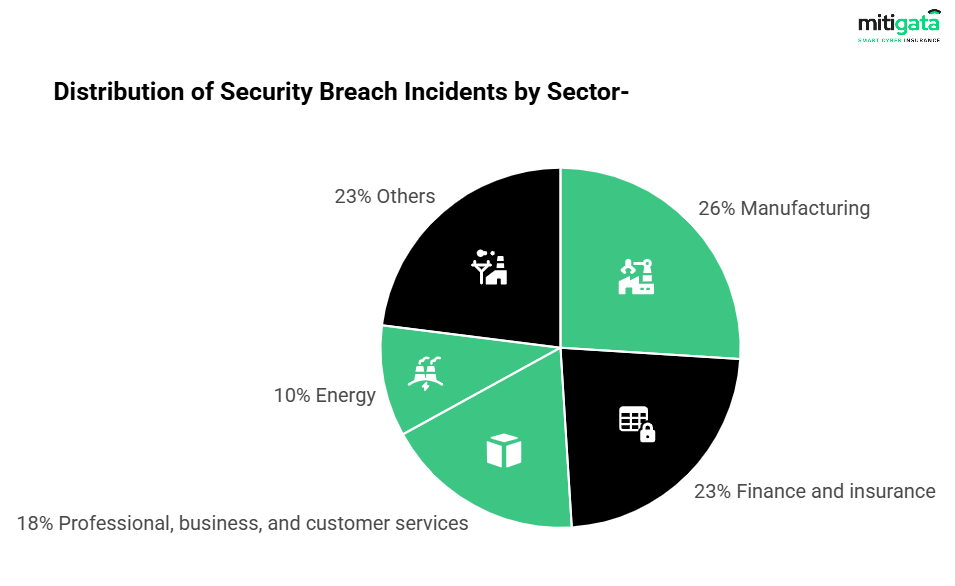Understanding the Cost of Data Breach: Financial & Non-Financial Impacts
Did you know that breaches caused by phishing take an average of 295 days to identify, according to IBM’s report?
That’s nearly a full year for businesses to realise they’ve been compromised.
And the costs?
In 2024, the average cost of a single data breach was $4.88 million, a 10% increase over the previous year.
These figures may appear startling, but they reflect the reality of data breaches today.
Reasons Over 800 Companies Opt for Mitigata
At Mitigata, we extend past conventional coverage to offer proactive management of cyber risks. Our method has achieved a 100% client retention rate, demonstrating the trust companies have in our services. What we offer your business:
Demonstrated Proficiency
We safeguard more than 800 businesses across over 25 sectors, ranging from logistics to major corporations, recognising the specific cyber threats each company encounters.
Defensive Strategy through Mitigata Console
Obtain special entry to the Mitigata Console, a system that enables you to:
- Monitor vulnerabilities and get notifications about possible threats.
- Detect and avert phishing schemes and the theft of credentials.
- Keep an eye on digital threats within your networks before they worsen.
Collaborative Alliances: We collaborate with India’s top insurance companies to provide extensive protection and dependable service when you require it most.
Market-Driven Pricing: Our expertise and relationships in the industry enable us to provide cost-effective coverage while maintaining strong protection, ensuring you receive the greatest value for your investment
What is a Data Breach?
A data breach takes place when an unauthorised person gains access to sensitive or private information. This may include personal information such as names, addresses, credit card numbers, or login credentials. In simple words, a breach is any incident in which data is accessed, stolen, or exposed without permission.
In this blog, we’ll explore the impacts of data breaches and discuss the steps to reduce the cost and damage caused by data breaches.
Financial Impact of a Data Breach
A data breach doesn’t just affect your company’s reputation; it can hit your finances hard. Let’s break down the key financial consequences:
Direct Financial Damages: Responding to a breach incurs significant costs related to investigating the breach, notifying customers of the breach, providing credit monitoring to customers, and recovering lost data.
Legal Fees and Settlements: Lawsuits from customers and regulators mean hefty legal fees and court costs that can quickly escalate.
Regulatory Penalties: Violating laws such as GDPR and HIPAA can result in substantial fines. Fines under the GDPR can range from 2% to 4% of an organization’s annual revenue or up to €20 million.
Loss of Intellectual Property (IP): If your company experiences a breach that results in the loss of sensitive data such as trade secrets, this could significantly impact your products, innovations, and/or competitive advantage.
Learn about other cybersecurity threats and how to protect against them.
Is Your Business Protected Against Cyber Risks?.
Identify potential vulnerabilities and learn how Mitigata’s tailored insurance plans

Non-Financial Impacts of a Data Breach
However, the actual cost of a data breach extends far beyond these immediate expenses. It also includes indirect costs, such as:
- Lost Business: Operational downtime and disrupted services can result in revenue loss.
- Reputational Damage: A damaged brand image can drive customers away and affect long-term profitability.
- Customer Churn: Following a breach, many customers may take their business elsewhere, especially if their personal information was compromised.
- Increased Security Spending: Companies often need to invest heavily in new security measures following a breach.
These costs compound, making data breaches not just a one-time financial setback but a long-term burden on an organization’s operations and growth.
Global Cost of Data Breaches: 2025 Sector & Territory Analysis
| Sector | Updated Avg. Cost (2025 est.) | Avg. Time to Contain | Territory | Updated Avg. Cost (2025 est.) | Avg. Time to Contain |
|---|---|---|---|---|---|
| Healthcare | $11.45 million | 329 days | USA | $9.98 million | 289 days |
| Financial | $6.51 million | 243 days | Middle East | $9.21 million | 311 days |
| Industrial | $6.02 million | 271 days | Benelux | $6.33 million | 265 days |
| Technology | $5.95 million | 260 days | Germany | $5.72 million | 235 days |
| Energy | $5.74 million | 288 days | Italy | $5.10 million | 254 days |
| Pharmaceuticals | $5.53 million | 285 days | Canada | $5.04 million | 249 days |
Most Affected Sectors by Data Breach in 2025-

Real-Time Case Studies of Data Breaches-
Case Study 1: AT&T (2025) – 86 Million Customer Data Leak
One of the most recent high-profile breaches occurred in 2025 when AT&T suffered a massive data breach. Personal details of 86 million customers, including social security numbers, phone numbers, and mailing addresses, were exposed on the dark web.
The breach not only resulted in immediate legal costs but also significant reputational damage to the company. The leaked data compromised customer trust, and recovery efforts required extensive PR campaigns, resulting in both financial penalties and a decline in customer retention.
Read this is case if you are planning to go for cybersecurity outsourcing
Case Study 2: Healthcare Sector Breach – $10 Million+ in Costs
In the healthcare industry, data breaches tend to be exceptionally costly due to the sensitivity of the data involved. A recent breach within an extensive hospital network resulted in over $10 million in total costs.
This included ransomware payments, legal settlements, and reputational damage, as sensitive patient data was exposed. The breach not only triggered immediate costs but also led to a lengthy recovery period, with increased patient churn and costly regulatory fines.
These case studies highlight the severe impact of data breaches, not only in terms of immediate financial losses but also in how they affect long-term business performance, customer trust, and operational efficiency.
Unlock the Secrets to Affordable Cyber Insurance Coverage

What Drives the Cost of a Data Breach?
Several key factors influence the cost of a data breach, including:
- Industry: Sectors like healthcare and finance tend to face higher breach costs due to the sensitive nature of the data they manage.
- Location: Breaches in regions like the US tend to be more expensive, partly due to stricter regulations and higher litigation costs.
- Company Size: Larger companies with more complex systems and a broader scope of data tend to experience higher breach costs.
- Data Sensitivity: The more sensitive the breached data (e.g., medical records, financial data), the more expensive the breach is to handle.
In addition to these factors, the duration of the breach and the response time are crucial in determining the total financial impact. The longer a breach remains undetected, the higher the cost due to prolonged exposure and damage.
The Role of Cyber Insurance in Data Breach Cost Management-
Cyber insurance helps to manage the expenses associated with data breaches by offering financial protection and recovery assistance. It helps businesses mitigate the significant economic and reputational damage that can result from cyber disasters, such as data breaches and ransomware attacks.
Businesses can protect themselves from these potentially devastating costs by investing in cyber insurance. Mitigata’s comprehensive cyber insurance solutions provide the necessary coverage to recover from breaches, reduce financial risks, and safeguard the digital future.
Protect Your Bottom Line - with Mitigata Cyber Insurance Coverage
We protects you from the average cost of data breaches & losses.

Safeguard Your Business with Mitigata’s Cyber Insurance
Data breaches are costly, both financially and operationally. As we’ve seen through real-world case studies and the rising statistics, the cost of a data breach can cripple a company’s financial standing, damage its reputation, and lead to long-term operational setbacks.
To learn more about how Mitigata can help secure your business with tailored cyber insurance coverage, contact us today or request a free cyber risk assessment to understand your specific coverage needs.
FAQs on True Cost of Data Breach in 2025
Q1. What is the main cost of data breaches?
In 2024, the average cost of a data breach was $4.88 million, a 10% rise over the previous year. This dismal number highlights a troubling trend in our increasingly digital world: data breaches are getting more common, sophisticated, and costly.
Q2. What is the most expensive data breach?
In 2017, Equifax experienced the largest cybersecurity breach, resulting in a financial loss of more than $1.4 billion.
Q3. What is the cost of a breach of contract?
The breach of contract cost includes compensatory damages that one party pays to another for failing to comply with specified terms and conditions. A court directs the individual that violated the contract to pay the other party enough money to go elsewhere for the services.
Q4. What is the cost of a GDPR breach?
The EU GDPR imposes a maximum fine of €20 million (approximately £18 million) or 4% of annual global turnover, whichever is greater, for infringements. However, not all GDPR violations result in data protection fines.
Q5. How much compensation for a data breach?
As per the UK GDPR Breach Compensation Calculator, the type of harm decides the severity amount, where a moderately severe breach helps you recover a compensation amount varying from £23,270 to £66,920.

